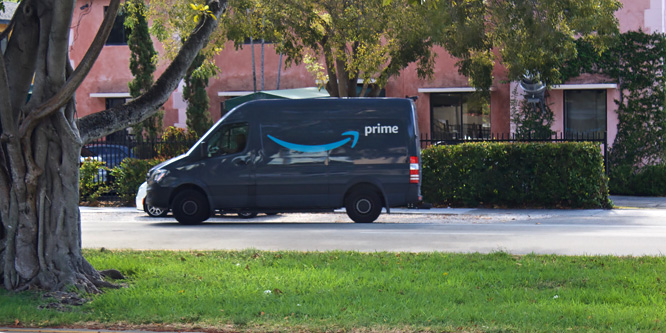
Photo: Getty Images/Lawrence Glass
September 24, 2020
Will homes of the future include ‘Amazon Rooms’?
The novel coronavirus pandemic has forced significant changes on how we live, how we shop and now it seems it could impact how we build houses. The home of the future might be built with e-commerce in mind, and the trend already appears to have started — at least in Hollywood.
Wealthy, single-family home buyers have begun adding a room in their homes built specifically for the drop-off and storage of Amazon packages so that they can be decontaminated before brought into the house, according to what one real estate brokerage CEO told Hollywood Reporter. This new amenity, dubbed an “Amazon Room,” has an analog in the mail receiving rooms in many large, high-end multi-tenant buildings. Packages delivered to single-family homes, however, tend to be left on the porch or near the mailbox, which can lead to theft.
Though touching contaminated surfaces is no longer believed to pose a significant risk for the transmission of the novel coronavirus, some maintain the belief that it is safest to sterilize incoming packages.
Before the pandemic, both Amazon and Walmart had been testing solutions that would allow for delivery directly into customer homes, as e-commerce grew more popular and package theft grew alongside it. Some characterized the problem as hitting epidemic proportions during recent holiday seasons.
Amazon launched a service in 37 cities in late 2017 called Amazon Key, which allows customers to have packages delivered directly into their homes by Amazon associates. When delivery people arrive at customers‘ homes, they verify that they are at the correct location via their scanner and request that Amazon unlock the door remotely so that they can drop off the package. Customers can watch the drop-off via Amazon’s cloud-based surveillance cam, which is activated for the duration of the delivery.
In 2019, Walmart began testing a service that went even further. Walmart’s InHome Delivery allows customers to have groceries delivered directly to their refrigerator. The service is still active, although Walmart’s FAQ indicates that it has not yet been expanded outside of its three initial test markets. The FAQ also includes a segment on protecting customers using the service and preventing the spread of the novel coronavirus during the pandemic.
Discussion Questions
DISCUSSION QUESTIONS: Will rooms in homes dedicated to receiving e-commerce packages become popular enough to change how deliveries are made in the U.S.? What other types of logistics solutions, such as Amazon Key, Walmart InHome and in-fridge grocery delivery, might be incorporated into “Amazon Rooms”?
Poll
BrainTrust
David Naumann
Marketing Strategy Lead - Retail, Travel & Distribution, Verizon
Lee Peterson
EVP Thought Leadership, Marketing, WD Partners
Recent Discussions







I can certainly see more homes having delivery drop-off lockers or other secure areas where packages can be left. Some of these will be lockable boxes which are outside of the home. However the idea of most homes having a kind of full-blown mail room where packages can be stored and decontaminated is far-fetched! It may be popular in Hollywood, but Hollywood is not representative of the vast majority of America!
Businesses are closing and people are out of work but wealthy people need a special room for Amazon package drop-off and storage. Sorry, I can’t even with this one.
I’m with you on this one, Georganne. I get the sanitizing thing, sort of, but you can always bring the items inside and stick them in a closet, garage, or storage room, and leave them for a few days, and then wash your hands. And, are we buying so much stuff now that we need special intake rooms? At what point do even the uber wealthy say “maybe we have enough stuff and really ought to cut back” when there is a pandemic along with societal upheaval and vast inequality? PS: It’s not just Hollywood that isn’t like the rest of us.
I googled “stupid rooms in rich people’s houses” and there are so many things I cannot comprehend. I get gift wrapping rooms (maybe) and my parents had a tornado shelter built into our house in Illinois (part of the town had been devastated by a tornado a few years earlier), but Amazon Rooms just made me laugh.
It is a clever concept that may have legs. The driving force behind rooms dedicated to home delivery of packages won’t necessarily be sanitation reasons. The key drivers will be avoiding porch thieves or keeping groceries at the proper temperature if the consumer is not home at the time of delivery. Rather than “Amazon Rooms,” another option is to outfit the side of the garage with built-in compartments with exterior access that can be locked. If consumers are interested in grocery deliveries, there could be three compartments for controlling temperature: regular, refrigerator and freezer.
An Amazon Room is certainly a nice vanity project for those who can afford and need to keep up with the Joneses in those areas. For rest of the folks who are comfortable with it, Amazon Key — into the home, garage or the walkout basement — is the next best option.
I remember when we had a discussion here when Walmart began offering a service to enter homes and have an associate load groceries in the cupboards and refrigerators. I know at the time I thought there was no way I would allow anyone in my home, especially if my kids were young enough to stay at home on their own. I still feel that way. I just don’t know if people will spend the money to build a separate room (or part of the home) that has security so that it does not lead to the other parts of the home. I look forward to other members’ feedback on this.
2020 has forced everyone to adapt and accept change in every aspect of our daily lives in ways we could never has imagined. Lifestyle, technology, health and safety, and style trends have all merged to accelerate and time compress new concepts and workflows. Working from home and online shopping will certainly influence home architecture, floor plans, and interior design. The design and integration of the home office and a secure room to facilitate deliveries and shipping of packages and food services will become common.
Retailers really want to get inside our homes.
Dedicated Amazon Rooms would appeal to the affluent – including Amazon Luxury shoppers. Yet for most of us, these new spaces are out of our budget.
Our family is far from posh yet our front enclosure already acts like an Amazon Room. This secure drop-off space protects packages from the elements and porch pirates and protects Amazon delivery workers from potential germs in our bubble.
While COVID-19 may boost home security and keyless entry tech sales, these innovations are moot when many of us intend to work from home over the long term.
The typical mud room in a home costs about $5,000 to $7,000. If anything, wealthier homeowners already have space to put packages and deliveries. Porch theft occurs less in wealthy neighborhoods than poorer ones. Mail rooms may expand slightly for large estates, but it’s unlikely they become a staple in single household buildings for the average consumer.
Other ways for retailers to enter the home might evolve however, and this can include variations in delivery such as standardization to garages, patios or porches. Order time special instructions aren’t always followed. Packaging also matters – especially on rainy days, packages are wrapped in transparent plastic to prevent rain damage, and placed inside of doorways or porches if small enough. Expect more efficiencies in how deliveries are made, plus new ways of transport before we see home standards change dramatically.
If a mud room is, as you noted, an “Amazon Room” it would likely be less. Based on the average cost of a new home in the U.S., it may be an additional 1 percent. Maybe not for everyone, but certainly not limited to the wealthy.
Gene — it’s hard not to note that the concept was introduced by the CEO of a retail brokerage to The Hollywood Reporter — this is all about the wealthy, at least that’s who might actually be thinking about it. The median personal income in the US is about $33k. I can’t see people sacrificing monthly rent or using food stamps to save up for an Amazon Room.
The median new home in the U.S. today costs about $320,000. Half the people who are buying are spending that much or more. Those folks who are using food stamps aren’t buying that new home. And for those that are, they won’t even see the cost of the “Amazon Room” in the price of the house.
Considering the surge of e-commerce orders, especially from Amazon, this may on the surface be the right idea conceptually. However we are living in a world where most consumers are riding out this pandemic and are very much in survival mode. A dedicated Amazon Room is not on the priority list, nor is it possible for the average American who is struggling to make ends meet.
Talk about your rich folks’ problem! It’s hard to think of this as a “thing.” So will your Walmart key work in your Amazon Room? And will you also need a FedEx foyer, a UPS UPS (Un-penetrable Package Station), and — possibly a DHL Deck to accommodate all deliveries? And what makes the rich think the pandemic will last forever? Do they know something we don’t know? Hard to take this one seriously.
Though I end up with a different conclusion, this is well played Ryan!
This isn’t a matter of “wealthy.” To add an “Amazon Room” to a new home being built would have de minimus costs. And no, one won’t need something different for each delivery service. You would pick and give them access to the room electronically. It could be ongoing access, let’s say for UPS, USPS, FedEx and your favorite supermarket or it could be access that you give when you order for specific retailers.
Gene, I was trying to have a bit of fun. But, seriously, “de minimum” is in the wallet of the beholder. Lots of folks here can’t pay their water bills, so extensions/remodels are out of the question.
I am sorry about missing the fun. But this isn’t a financial problem. For more than half the people who buy a new home the cost of including a technologically controlled receiving room won’t even be see in the price of building the house. More than half the people in the U.S. spend over $300,000 in building a new home. Those folks are not worried about their water bills.
This discussion brings a smile to my face.
Somebody is thinking about the future. Let’s go back to the discussion of several weeks ago where several of you answered my question as to why BOPIS. Two of the reasons included 1.) scheduling to be home when the delivery is supposed to come and 2.) security of having packages left at the doorway.
Part of today’s solution is Amazon Key. That may be the short-term solution. Let’s keep the “Amazon Room” in quotes as we look to the future of that room. Won’t it be the Amazon Room, UPS room, the FedEx room, and the Stop and Shop room and the Safeway room? It will be a simple room for receiving packages (having absolutely nothing to do with decontamination).
How about the cost? Do most new homes today have two-car garages? What would be the increase in cost for such an “Amazon Room” to add on to two-car garage? It would be de minimis compared to the cost of the new home. This isn’t a cost issue. This is a convenience issue. This is an issue that can be easily solved with technology as the delivery providers work together to have a system that allays the concerns that people now experience with the accelerated move to online buying.
This idea has nothing much to do with wealth or Amazon. A delivery room wouldn’t be much harder to install than a delivery door — along the lines of a doggy door. Security can be assured by one-way hinged bars like those tire things that stop you from going the wrong way. With fast home delivery expected from all retailers this is a brilliant idea. But let’s not make “Amazon” the “Kleenex” of delivery.
This would be a heck of lot safer and easier than letting someone into your house with your phone. Now sure, there will be a luxury refrigerated version for perishables for those who can afford it. Why would we resent that?
Ian, they have tried it. It was called Streamline and it didn’t work for a number of practical reasons — the refrigerators were in garages so (a) you had to have a garage and (b) you had to be able to avoid driving into the box. Turned out the latter was a far larger problem than the former.
I guess this room would be a necessity, if the house staff who would sanitize the packages and then store the goods in their proper places is big enough. I think this room could make a great playroom for the children within a year. Just saying …
If homes of the future were to have an Amazon Room, it would be one that showcased the connected, experiential home in competition with Apple, Google, and possibly Walmart as they compete for a share of life (not just wallet or mind).
It will not be to be a receiving room for packages. That function will continue to be the front door or porch area, or the doorman of a Manhattan apartment building. Technology solutions that provide limited access to specific spaces will be far more popular than dedicated rooms for the ultra-wealthy.
Short answer – no. This is a long term solution to a short term problem. From a decontamination perspective, the experts stopped recommending that we wipe down everything months ago. Surfaces carry a low risk of transmission. Building a separate room just for decontamination? I don’t see it. Locked secure rooms for package deliveries? That’s a first world problem in the extreme. If you have the resources to build a room just for deliveries, it would be far cheaper to just have your butler get the package.
In all seriousness this reminds of the discussions about having delivery people come into your house to restock your pantry or fridge. The houses of the future have been imagined with cupboards and refrigerators accessible from the outside for delivery. Maybe I see how it could work, but it’s also a LONG way off in my opinion.
I would definitely consider this for a new home. The way I think it would work is that there is an outer door to the vestibule for package delivery and an inner door not accessible by Amazon. That would afford protection from COVID-19 but also from porch pirates which is actually a bigger concern, I believe.
I think this is a glimpse into the future. I agree with some other comments that other types of logistics solutions such as exterior/interior locks, access to garages, drop boxes similar to mailboxes, etc will become commonplace. It will be less about decontamination and more about security, convenience and packaging innovation/sustainability and enabling future autonomous delivery methods.
While this has been positioned as a nice-to-have for the wealthy, I do think it should be taken seriously and will play out over the years in ways we can’t imagine but in ways Amazon and Walmart have already patented or are working to patent.
Ha! I wish i had one! My foyer is the de facto version of that anyway, what a mess!
No wonder stores are closing and malls are dying. The new retail store is your home! Amazon can open your front door, Walmart can stock your refrigerator, and now cementing the future of retail, you can have your own dedicated shipping and receiving room.
No, I do not think this will become enough of a thing to impact how deliveries are made. Yes, we have an area in our home where the packages go to sit but I would not dedicate a room to this and never got behind the Amazon Key/Walmart InHome ideas.
When I was a kid, I remember a little box built into the wall next to the backdoor of our home. It was used for the milkman to drop off milk and pick up empty bottles. That box was probably about a foot wide and a little taller. Overtime the delivery service of milk went by the wayside. Well, it seems like we’re back with home delivery. It’s interesting to note how the products and reasons to have a delivery box or a system for home delivery have changed. The old expression that comes to mind: Everything old is new again. This time around, technology takes delivery to another level.
Excuse me while I stroke my grey beard and offer a history lesson. The concept of a secure, unattended home-delivery locker first came to my attention circa 1998, when I covered an outfit called Port. Essentially a steel box bolted to the front or back stoop of a home, the solution was not temperature controlled, so okay for dry cleaning but not great for perishables.
Around the same time, online grocery pioneer Streamline was making unattended deliveries to partially-refrigerated cabinets installed in home garages in the tonier suburbs of Boston.
There was also discussion (probably by me) of a through-the wall delivery box that would allow deliveries through an exterior door. Contents could be later accessed through an interior door. I called it an “air-lock” concept. These might work as retro-fits to existing private homes.
None of these ideas was motivated by a concern for sanitation or decontamination.
Now the Amazon Room idea discussed here, it may be argued, is essentially a larger-scale “air-lock” or Streamline cabinet. Celebrities who fear they may be targeted by stalkers may install such facilities next to their safe rooms if if makes them feel more secure. I suppose if your residence (or your ego) is vast enough to require a service entrance….
It’s deja vu all over again — remember when homes had insulated milk boxes outside for weekly dairy deliveries? Calling a place to securely receive goods an Amazon Room is a PR coup for Bezos.
I don’t see people remodeling houses to add delivery rooms. In some areas there are already mud rooms which can be for the purpose. I think given the increased volume in delivery and package sizes, the mail slot/post box concept could use a reinvention into a package slot/package locker attached to the dwelling. That makes more sense than putting an package room into a house.